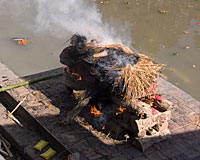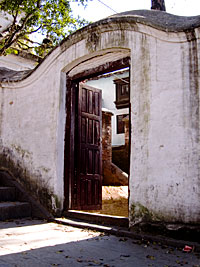Pashupatinath
It was well past noon before I dragged myself out of the comforts of Thamel and caught a taxi to Pashupatinath. Nestled on a hillside beside the Bagmati River, Pashupatinath is one of the holiest sites in the world for Hindus, second only to Varanasi in India.
Pashupatinath consists of a large temple which is open only to Hindus, surrounded by a number of smaller shrines and then down on the banks of the Bagmati are the burning ghats where bodies are cremated. After walking around the various pagodas and little temples I made my way across the river on one of the small foot bridges and up the hillside on opposite bank past a series of eleven small temples of Shiva to the top of a terrace.
 I sat up above the river on the terrace where there were some wooden benches whose beams seemed perhaps deliberately too far apart to be comfortable, as if comfort were not something to be found here. From the temple across the river came a continual ringing of bells and the sound of a flute which seemed to irritate the resident flock of pigeons sitting on the roof. Every few minutes the pigeons would launch off into a circuitous arcs seemingly blown like leaves, streaking along the river in a cloud so thick it was impossible to distinguish individual birds. Below me another funeral pyre was being prepared. After washing away the ashes of the last fire, workers began stacking cordwood and bamboo at cross patterns like Lincoln logs and then over the wood were draped long garlands of marigold flowers. In each corner of the pyre was a bamboo pole with leaves still at the top to form a canopy over the wood. Around these poles they slowly wrapped more marigold garlands and over the top they laid a piece of red silk. This pyre was for an upper caste person while farther down the river less ornate pyres were still burning. In the air I could smell the smoke of burning bamboo which mixed with the vague odor of burnt flesh though I could never decide whether or not that was merely my imagination.
I sat up above the river on the terrace where there were some wooden benches whose beams seemed perhaps deliberately too far apart to be comfortable, as if comfort were not something to be found here. From the temple across the river came a continual ringing of bells and the sound of a flute which seemed to irritate the resident flock of pigeons sitting on the roof. Every few minutes the pigeons would launch off into a circuitous arcs seemingly blown like leaves, streaking along the river in a cloud so thick it was impossible to distinguish individual birds. Below me another funeral pyre was being prepared. After washing away the ashes of the last fire, workers began stacking cordwood and bamboo at cross patterns like Lincoln logs and then over the wood were draped long garlands of marigold flowers. In each corner of the pyre was a bamboo pole with leaves still at the top to form a canopy over the wood. Around these poles they slowly wrapped more marigold garlands and over the top they laid a piece of red silk. This pyre was for an upper caste person while farther down the river less ornate pyres were still burning. In the air I could smell the smoke of burning bamboo which mixed with the vague odor of burnt flesh though I could never decide whether or not that was merely my imagination.
After an hour of preparation they brought out a body wrapped in linen and lying on what amounted to a bamboo ladder borne by four Hari Krishna’s who lifted the body up on to the pile of wood, covered it with grasses and then, with very little additional ceremony, they lit the pyre. Throughout this process the family of the deceased, who in this case was some sort of dignitary since the pyre was on one of the upper caste platforms, followed behind the Haris signing various songs in Hindi. The family was dressed in white the traditional Hindu color of mourning. Once the pyre was lit and the songs finished the family threw little bits of marigold petals on the fire and then retreated back into the building behind the ghats where there are rooms for the traditional Hindu mourning ceremonies.
I’ve remarked before on the number of times death has come up in my travels, but this certainly was the most culturally jarring thing I have witnessed thus far. I’ve been to a number of funerals in my life and looked in on a couple of autopsies before and the dead are always a strange site, but I had never witnessed a body being destroyed in flames before and something about it was very disturbing. You can’t actually see the body burn because the wood and grass is hides it, but it’s still a very disquieting just to know that under the grass and wood is a once living human being. I have often thought that I would rather be cremated than buried and I still think that I would, but I’m not sure I would want anyone to watch.
 After watching the pyre burn for a while I recalled a horrific story I read in the Indian paper about a woman whose family could no longer afford to pay for her health care and since she was catatonic they simply took her to a crematorium and left the body. The man who prepared her fire was about to lift her body into it when he noticed tears in her eyes. At the time I found the story disturbing, but now as I remembered it it produced a slight feeling of vertigo and dizziness as I thought of the woman unable to move and thinking that she was going to be burned alive, able to communicate the pain and loneliness she must have felt only by the welling of tears in her eyes.
After watching the pyre burn for a while I recalled a horrific story I read in the Indian paper about a woman whose family could no longer afford to pay for her health care and since she was catatonic they simply took her to a crematorium and left the body. The man who prepared her fire was about to lift her body into it when he noticed tears in her eyes. At the time I found the story disturbing, but now as I remembered it it produced a slight feeling of vertigo and dizziness as I thought of the woman unable to move and thinking that she was going to be burned alive, able to communicate the pain and loneliness she must have felt only by the welling of tears in her eyes.
Overcome with a sort of panicky feeling, but a feeling that was distinctly different than an actual panic attack to which I am prone; this was more a feeling of the world spinning as if I had for the first time become aware that even while standing still we are moving at around twenty thousand miles per hour and could feel the motion in my head; I decided to head back to Thamel. I don’t have a real distinct memory of getting down, I could not really say how long I had even been up on the terrace. I remember walking down the steps from the terrace because I stopped to make a quick photograph of a doorway that had caught my eye earlier and somehow I centered my attention for long enough to photograph it, but then I don’t remember much except that the sky was just then nearly obliterated by a flock of circling pigeons whose flight I watched until I realized I was still very dizzy and needed to sit down again.  I remember thinking that the pigeons looked like a broken kaleidoscope whose fragments had gotten stuck in my eye. And then I leaned against a bench for support and looked up at a little temple or pagoda rather that was next to me and saw the Kama Sutra carvings that often adorn the roof beams of temples in Nepal.
I remember thinking that the pigeons looked like a broken kaleidoscope whose fragments had gotten stuck in my eye. And then I leaned against a bench for support and looked up at a little temple or pagoda rather that was next to me and saw the Kama Sutra carvings that often adorn the roof beams of temples in Nepal.
I leaned there for some time thinking that about the cycle of birth love and death that makes up our lives and that at Pashupatinath the cycle has become a singularity so that the distinction between life and death no longer exists. The strange spectacle around me had brought birth love and death together in one place and compressed it down as if to say, despite the procession of time which makes it seem like a cycle, this progression is in fact not a progression, but a single point from which all other things emanate. These thoughts gradually pulled me out of my dizziness and the feeling of falling away from myself until at some length I was able to find my way back to Thamel.
And as the taxi dropped me off in front of my hotel, it occurred to me that losing one’s mind might be one of the central attributes of traveling in the first place; not necessarily going crazy, which really I am not, but finding one’s mind displaced enough that it begins to feel slightly alien, as if certain contexts which we are raised in and simply accept without ever thinking about become suddenly out of their element and foreign as we absorb different, new and strange contexts.
Thoughts?
Please leave a reply:
All comments are moderated, so you won’t see it right away. And please remember Kurt Vonnegut's rule: “god damn it, you’ve got to be kind.” You can use Markdown or HTML to format your comments. The allowed tags are
<b>, <i>, <em>, <strong>, <a>. To create a new paragraph hit return twice.